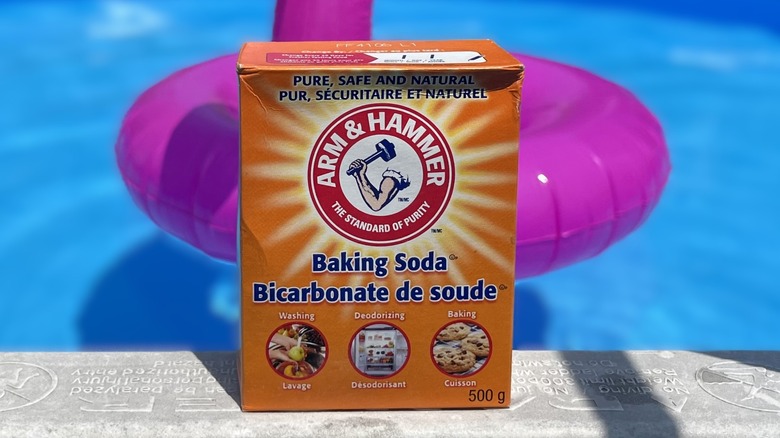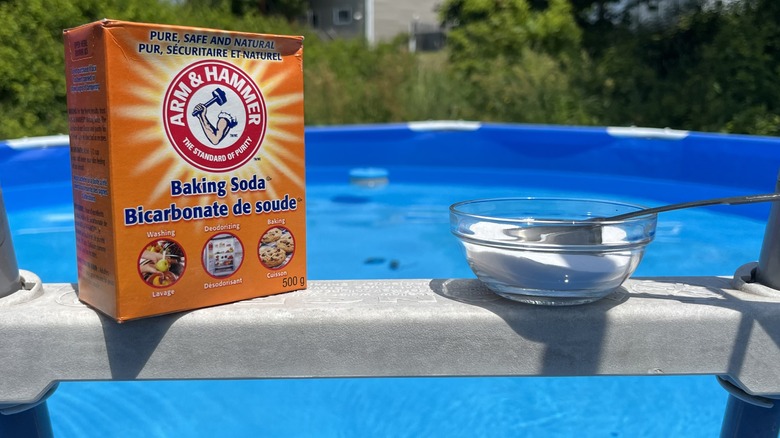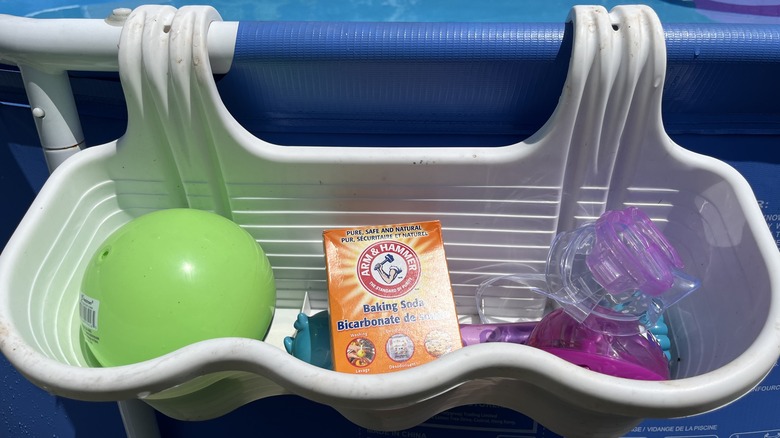Handy Ways To Use Baking Soda In Your Pool To Keep It Clean
We may receive a commission on purchases made from links.
Having your own pool is one of the great joys in life, especially on a hot sunny day. A lot of work goes into keeping a swimming area clean. There's plenty to do, from water treatments and filter changing to scooping out debris and scrubbing the surrounding deck and equipment. One of the mistakes everyone makes when opening up their pool for the summer is not having the right chemicals on hand to get started. Fortunately, there's a natural pool cleaning product in most pantries.
Baking soda, or sodium bicarbonate, was first discovered in the 1790s by French surgeon Nicolas LeBlanc, and was refined for mass production by Ernest Solvay in the 1860s. Initially called soda ash, this versatile product was employed in the production of common day items including porcelain, glass, soap, and paper. Today, baking soda is used for a wide range of purposes including cooking, cleaning, medicine, fungicides, fire extinguishing solutions, and of course, pool maintenance. You can pick up a box of baking soda at any grocery store, or buy a bulk 15 pound bag from shops like Walmart for around $29. Check out some handy ways this salty powder treats water, cleans equipment, and even tackles tile grout.
Treat pool water to balance pH and prevent corrosion
One issue swimming pools face is an imbalanced pH, which leads to corrosion on one end, and messy bacterial growth on the other. The pH in your pool tells you if the water is acidic, neutral, or alkaline (basic). High acidity is harsh on swimmers, the plumbing, and the filtration system, while high alkalinity impedes chlorine from doing its job and killing germs. The numbers on a pH scale range from zero to 14. Numbers under seven represent acidic water and numbers over seven represent base. The U.S. Centers for Disease Control and Prevention recommends a pH balance of 7.0 to 7.8 to reduce bacteria and increase the lifespan of hardware. Test strips tell you where your swimming area sits on the scale. If things are slightly too acidic, baking soda can help clean things up.
Sodium bicarbonate has a pH of 8, making it an alkaline substance. Adding it to your swimming pool increases base levels, reducing potential problems caused by acidity. Arm and Hammer recommends adding 1.5 pounds for every 10,000 gallons of water. This should increase alkalinity by 10 ppm (parts per million). After adding the powder, let it dissolve for about six hours. Test again and add more as needed, with an additional six hour wait between applications. Balancing the pH is just one of many baking soda cleaning hacks that are worth trying, such as scrubbing residue from the poolside.
Use baking soda to clean tile grout and poolside furniture
We know what happens when you put baking soda in your pool, but what about using it on other components of the swim space? Grout is one area that often needs a little extra care for pool owners. To clean interior tiles before filling your pool, or for exterior deck grout, handcraft a DIY cleaner using equal parts baking soda and water. Spritz the grout with hydrogen peroxide before applying this paste to boost the cleaning power of the sodium bicarbonate. The former adds oxidization to break down stains while the latter creates a subtle abrasion to scrub away dirt. A similar mix works on deck furniture.
Pool chairs and loungers are often left to the elements, including rain, blowing dust, falling leaves, and other debris. Like tile grout, you can tackle the accumulating furniture grime with baking soda. To get started, mix four parts powder with one part water and scrub with a rag. Rinse and revel in your rejuvenated deck furniture. Being natural and a food product, this water and baking soda mix is also a safe option for cleaning pool toys. From balancing pH to keeping the swimming area shiny and clean, baking soda is an easy-to-find, affordable alternative to harsh chemical cleaners for your pool.


